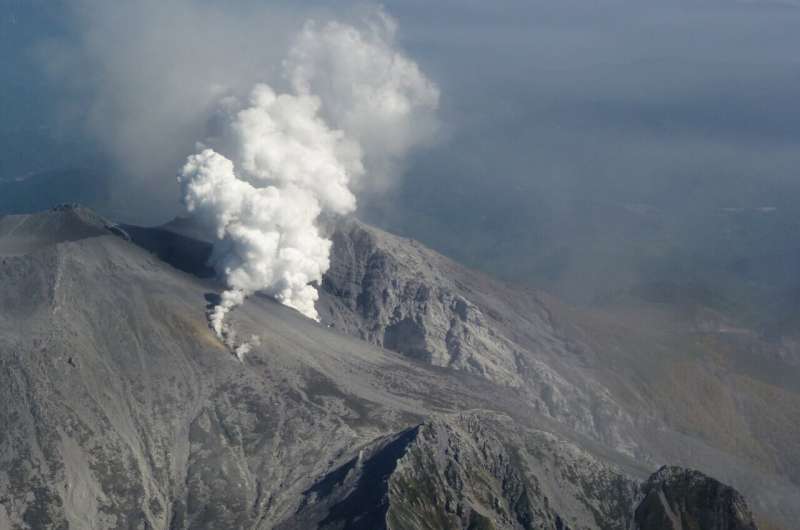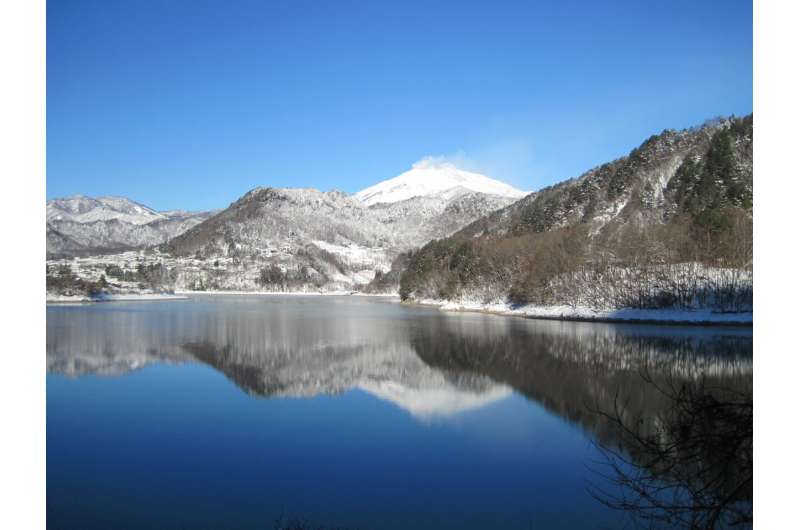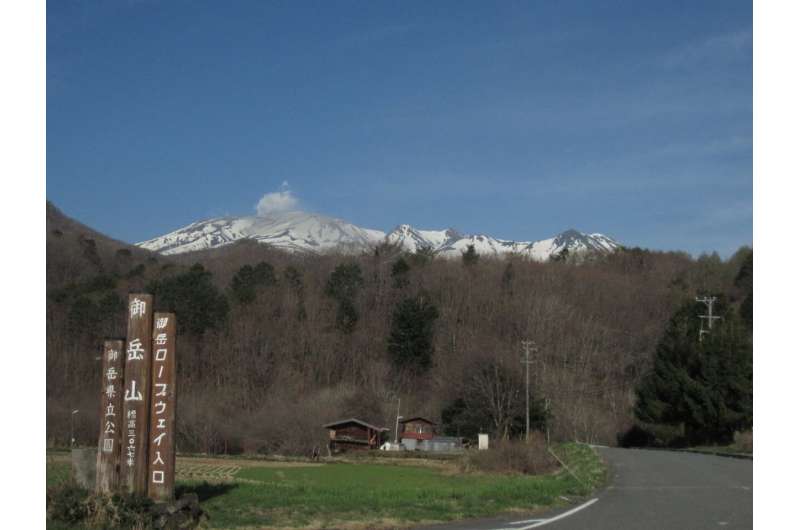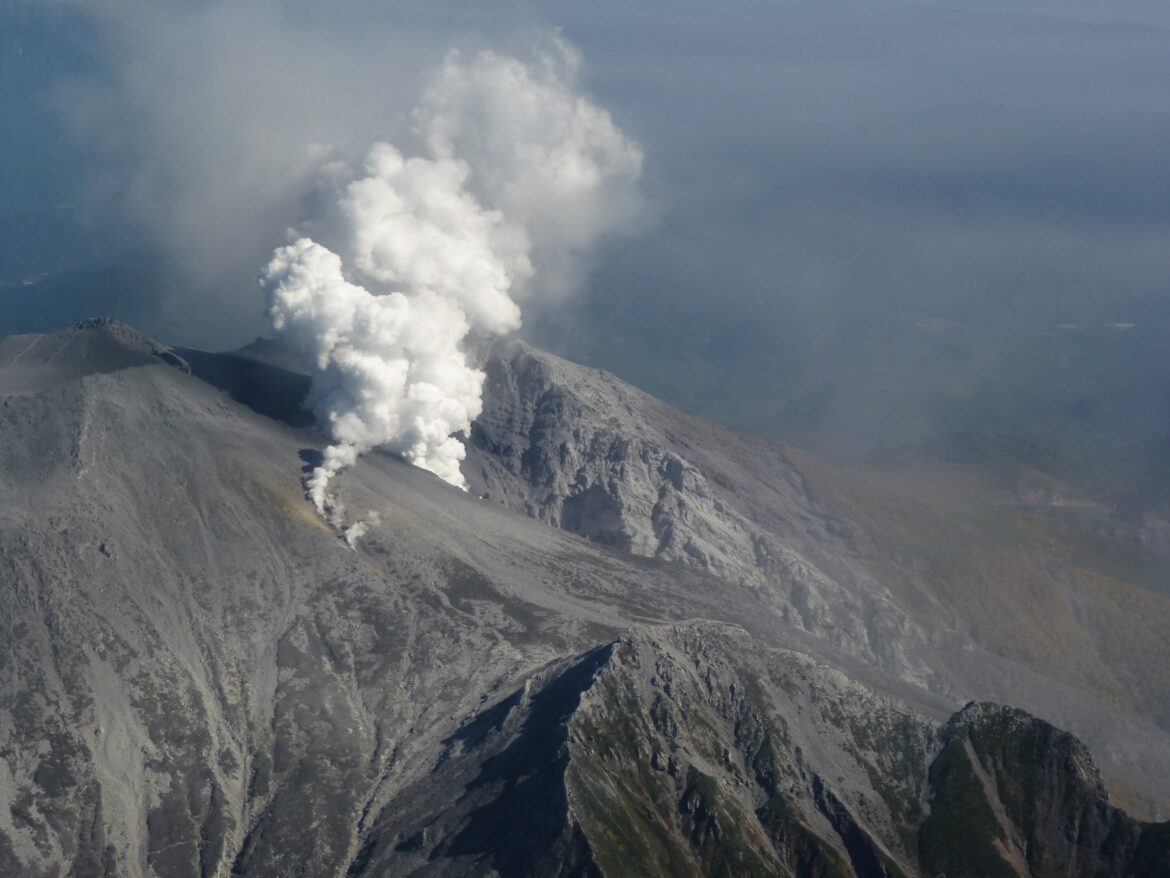
Aerial view of Ontake Volcano, Honshū Island, Japan. Credit: Dr. Koshun Yamaoka.
For communities living in the shadow of a volcano, early warning systems are a lifeline—but mistrust in these warnings can have deadly consequences. To avoid false alarms, it is vital that scientists seek more reliable ways to monitor volcanoes.
A new study published this week in the journal Seismica by University of Oxford researchers has investigated a seismic signal known as shear-wave splitting for providing scientists and communities with an essential early warning of a dangerous eruption.
Large movements of magma and rock inside a volcano cause seismic waves to be released, but these signals can be challenging to untangle. The goal of this research was to seek a usable parameter which could not only predict if an eruption was set to occur, but also if the eruption was going to be particularly damaging.
Shear-wave splitting
Shear-wave splitting is a phenomenon where seismic shear-waves travel at different speeds depending on their polarization. Cracks and fractures inside the rock can slow down seismic waves, but have a larger delaying effect on seismic waves that travel across the cracks and fractures. If the cracks are aligned in one direction, then the amount of shear-wave splitting increases.
Magma and fluids moving beneath a volcano exert stresses on the surrounding rocks, causing cracks to open in certain orientations and close in others. Examining changes to shear-wave splitting through time can be really useful for scientists, as it tells them where these cracks are opening and closing.

Ontake Volcano covered with snow. Credit: Dr. Shinichiro Horikawa.
But the research team wanted to take this a step further—and test whether the larger stress changes during an explosive eruption also caused a more significant change to the amount of shear-wave splitting.
“Seismic anisotropy—or the effect of rock composition and internal fractures on the speed of shear-waves oscillating at right angles to each other—is a well-documented phenomenon,” said Professor Mike Kendall (Department of Earth Sciences, University of Oxford).
“When we reflected on how anisotropy increases as the pressure inside a volcano builds, we were excited to explore if we could detect these changes, and if this could be a distinctive signal which could be applied to early warning systems.”
Observations at Ontake volcano
The research team put this theory to the test by examining seismic signals during two eruptions of Ontake Volcano, on Honshū Island in Japan. The 2007 eruption was small and had much less of an impact on the surrounding community, whereas the 2014 eruption was larger, more explosive, and sadly more deadly.
They were excited to discover that during the smaller eruption, the amount of shear-wave splitting remained constant throughout, but during the larger eruption the amount of splitting doubled just before Ontake exploded. The team believe that the larger stress change during the 2014 eruption increased the observed shear-wave splitting, indicating a useful relationship between the amount of splitting and the size of the eruption.

View of Ontake Volcano in the distance. Credit: Dr. Shinichiro Horikawa.
Co-author Professor Toshiko Terakawa (Nagoya University) noted, “The focal mechanisms of volcano-tectonic earthquakes changed drastically before and after the 2014 eruption. Integrating data from shear-wave splitting and earthquake focal mechanisms could provide deeper insights into conditions required for an eruption to occur.”
Co-author Professor Martha Savage (Victoria University of Wellington) added, “The records around two eruptions on Ontake volcano in Japan have been able to show that the method can not only show changes before eruptions, but that they can potentially help to predict the size of an eruption. This work was an example of how cooperation among people from around the globe can address important societal problems.”
Discover the latest in science, tech, and space with over 100,000 subscribers who rely on Phys.org for daily insights.
Sign up for our free newsletter and get updates on breakthroughs,
innovations, and research that matter—daily or weekly.
A valuable early warning system
Because the change in shear-wave splitting occurred before the eruption of Ontake began, scientists monitoring the volcano will be able to use this parameter as both a vital early-warning system and an indicator of how damaging the eruption could be. This offers a new way to protect local communities from the devastating impacts of a volcanic eruption.
“We expect to see these effects at other volcanoes across the globe, not just at Ontake Volcano,” said co-author Dr. Tom Kettlety (Department of Earth Sciences, University of Oxford).
“As changes in volcanic stress occur prior to an eruption, we anticipate that we would see changes in shear-wave splitting. This could be a valuable tool for early warning of volcanic eruptions, especially for local communities.”
This work is part of a vibrant research program in volcanology and geothermal energy at Oxford. Recently published work based on the “zombie” volcano Uturuncu has shown unique insights into the architecture of volcanoes, which complement the type of hazard monitoring conducted at Ontake volcano.
More information:
Michael Kendall et al, Changes in seismic anisotropy at Ontake volcano: a tale of two eruptions, Seismica (2025). DOI: 10.26443/seismica.v4i1.1101
Provided by
University of Oxford
Citation:
Eruption loading: New approaches to earthquake monitoring at Ontake volcano, Japan (2025, May 1)
retrieved 1 May 2025
from https://phys.org/news/2025-05-eruption-approaches-earthquake-ontake-volcano.html
This document is subject to copyright. Apart from any fair dealing for the purpose of private study or research, no
part may be reproduced without the written permission. The content is provided for information purposes only.


AloJapan.com